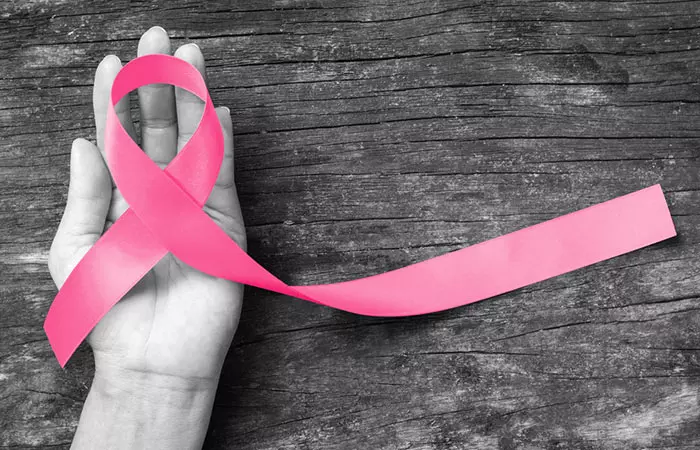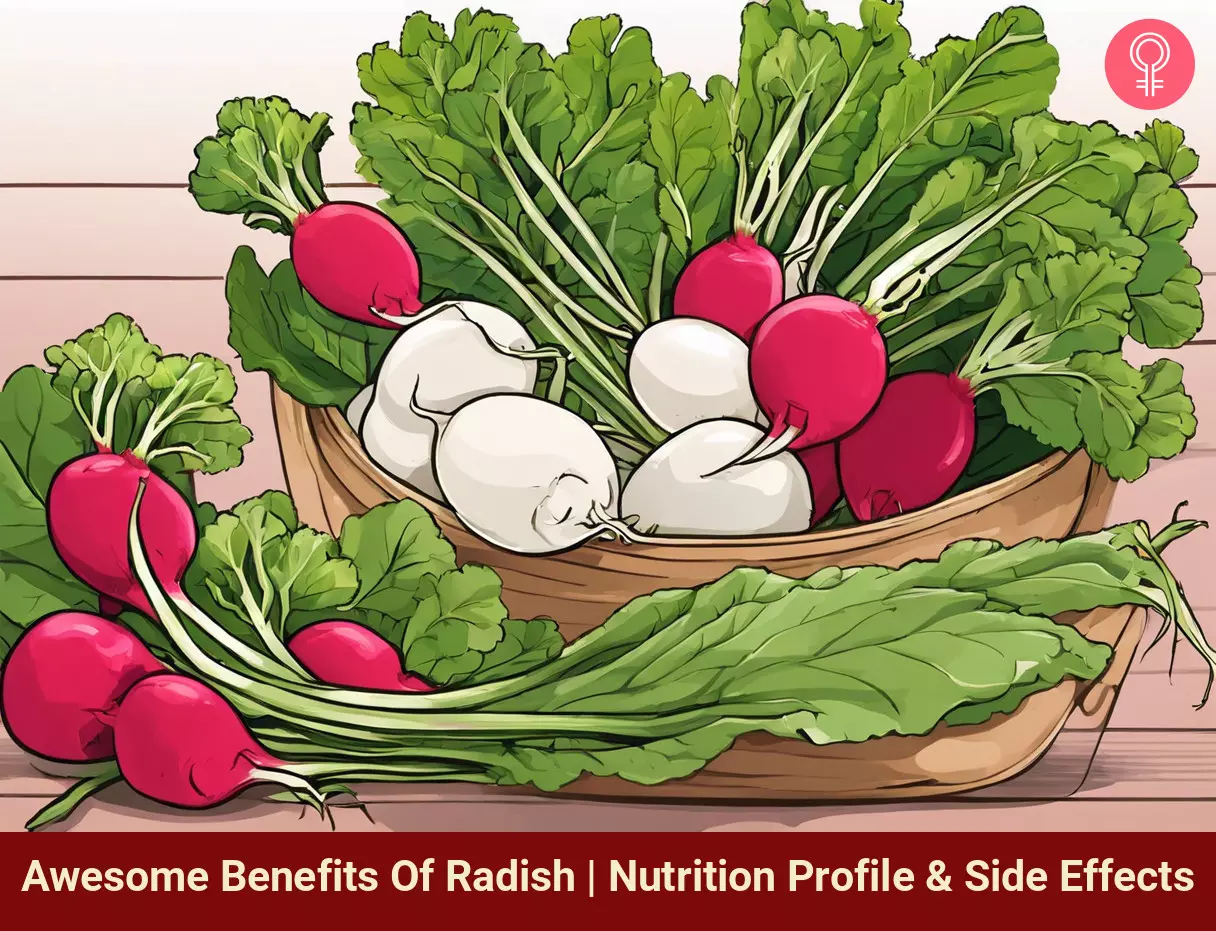Radish Benefits: 8 Powerful Ways This Veggie Boosts Health
This nutritious, crunchy veggie can enhance your dishes as well as your overall health.

Image: Shutterstock
Radish is loved by many people for its crunch. But did you know that radish benefits your health? Radishes (Raphanus raphanistrum subsp. sativus) are loaded with many beneficial nutrients and offer many health benefits that can boost your overall well-being. Knowing these benefits can help you make better dietary choices for a healthier lifestyle. They are a rich source of vitamin C, an antioxidant that combats free radical damage (1). Additionally, potassium, magnesium, folate, calcium, and riboflavin are also present in these root vegetables.

Sulforaphane is an antioxidant found in radish. It is a type of isothiocyanate that can potentially inhibit certain types of cancer (2).
The accumulation of bilirubin in the body causes jaundice (3). Consumption of radish decreases the levels of bilirubin. Also, the indoles present in this vegetable are known for their anticancer properties (4).
Learn more about the benefits of radish from the article below. Keep reading!
 Know Your Ingredient: Radish
Know Your Ingredient: RadishWhat Is It?
A type of cruciferous vegetable.
What Are Its Benefits?
Radishes are rich in antioxidants and help prevent oxidative stress, reduce the risk of certain cancers, improve heart health, digestion, liver health, and joint health, and aid weight loss.
Who Can Consume It?
Radishes can be safely consumed by all. However, it is safer to seek a doctor’s advice regarding radish consumption during pregnancy.
How Often?
½ cup daily
Caution
May cause hypothyroidism and hypoglycemia and increase the chances of gallstones.
In This Article
What Are Radishes?
Radishes are edible root vegetables from the Brassicaceae family
. These crunchy vegetables have a pungent flavor and are available with a peppery, sweet taste. They are close relatives of cabbage, turnips, broccoli, kale, and mustard greens. These are less starchy when compared with other root vegetables and are available in red, black, white, purple, and yellow colors.
 Trivia
TriviaThese greatly vary in color, shape, and taste and are available in many types. Scroll down to find different types of radishes.
Key Takeaways
- Radish is of high fiber content, making it a good option for weight loss, and it even benefits the digestive system.
- Radishes reduce the content of free radicals in our body, due to its vitamin C content, which in return helps regulate glucose absorption in the intestine and keep diabetes in control.
- It can help remove toxins from the liver and is a common remedy for jaundice..
- The sulforaphane content of radish can be beneficial for osteoarthritis
Types Of Radishes

There are many varieties of radishes. However, the most common types of radishes include:
- Daikon radish
- Korean radish
- Cherry Belle
- April Cross
- French Breakfast
- White Icicle
- Early Scarlet Gold
- Plum Purple
 Trivia
TriviaThese are some of the common types of radishes available worldwide. We will look at the nutritional breakdown of radish in the following section.
Nutritional Value Of Radishes

According to the U.S. Department Of Agriculture, one cup of slices (116 g) of radish contains:
- Calories: 18.6
- Water: 111 g
- Protein: 0.789 g
- Fat: 0.116 g
- Carbs: 3.94 g
- Fiber: 1.86 g
- Sugar: 2.16 g
- Calcium: 29 mg
- Iron: 0.394 mg
- Potassium: 270 mg
- Sodium: 45.2 mg
- Magnesium: 10 mg
- Manganese: 0.069 mg
- Vitamin C: 17.2 mg
- Thiamin: 0.014 mg
- Riboflavin: 0.045 mg
- Niacin: 295 mg
*Values sourced from USDA, radishes, raw
Radish is a powerful vegetable with many unique nutrients. We have seen some of them in this section. But are radishes good for you? If yes, what are their health benefits?
Health Benefits Of Radishes
Isothiocyanates are the most powerful compounds in radishes. These antioxidants promote heart health and help combat cancer. While these antioxidants may also aid diabetes treatment, the fiber in radishes may promote digestive health and weight loss.
1. May Improve Cardiovascular Health
Extracts of radishes were found to influence nitric oxide production in rat studies. This causes the blood vessels to relax and can lower blood pressure eventually (5). Monster radish, also called Sakurajima daikon that is cultivated in Japan, was also found to have similar properties (6).
Nitric oxide also plays a role in relaxing the smooth muscle tissue and increasing the regional blood flow. It also inhibits platelet adhesion to the blood vessel walls. All these benefits can help reduce the risk of atherosclerosis (7).
2. May Lower Cancer Risk

Radishes belong to the family of cruciferous vegetables. These vegetables contain compounds that are broken down into isothiocyanates when combined with water (8). These isothiocyanates may help combat different forms of cancer.
The isothiocyanates in radish seeds were also found to induce cell death in lung cancer cells (9).
Radish was also found to exhibit chemopreventive effects in the case of breast cancer. In addition, it could directly inhibit the growth of cancer cells and induce cancer cell death. Hence, it can be a useful antitumor agent and play a role in cancer treatment and prevention (10).
These preventive effects of radish on breast cancer can be attributed to its sulforaphane content (11).
3. May Aid Diabetes Treatment
Radishes have antidiabetic effects. They strengthen the antioxidant defense system of the body and reduce the accumulation of free radicals. This promotes energy metabolism and reduces glucose absorption in the intestine, thereby helping individuals with diabetes (12).
4. May Promote Digestive Health

Radishes are good sources of fiber and may enhance digestive health. The same holds for the leaves of the vegetable. Rats fed with radish leaves showed enhanced gastrointestinal function (13).
Radish has been used ethnically as an aid for digestion, stimulant, laxative, and treatment for stomach disorders(3).
5. May Aid Weight Loss
Although we don’t have any direct research linking radishes to weight loss, the fiber in these veggies may help with weight loss. In addition, studies show that a high-fiber diet could be very beneficial for weight management (14).
Radishes are also low in calories. One large radish contains about 6 calories (15). Hence, they can be an excellent addition to a weight loss diet.
6. May Treat Kidney Stones
A diet containing radish was found to increase the excretion of calcium oxalate through urine (16). This could decrease the likelihood of the minerals getting accumulated inside the urinary tract and forming stones.
However, more research is warranted in this regard. Consult with your doctor before using radishes specifically to treat kidney stones.
7. May Help Prevent Osteoarthritis

The sulforaphane in cruciferous vegetables, including radish, can be beneficial for osteoarthritis (17). The compound works by preventing cartilage destruction in cells. More research is needed to understand the mechanism of radish in the treatment and potential prevention of osteoarthritis.
8. May Promote Liver Health
Cruciferous vegetables, including radish, can aid the detoxification of toxins in the liver. Studies show the liver-promoting effects of Spanish radish, a prominent radish type. The radish contains high concentrations of glucosinolates, which help promote liver health (18).
Radish is used as a household treatment for jaundice and other related liver diseases in Indian and Greeko-Arab folk medicine (12).
In another study, a bioactive chemical in radish (called MTBITC) was found to be effective in treating non-alcoholic fatty liver disease (19).
Though radish is among the healthiest vegetables, not everyone can consume it. In addition, there are a few concerns associated with the vegetable.
What Are The Side Effects Of Radishes?
Although radishes have benefits, there are some cases where side effects of eating radishes have been reported. People with low levels of blood sugar and thyroid hormone can face some adverse effects.
- May Aggravate Hypothyroidism
Cruciferous vegetables, like radish, contain goitrogenic substances that may interfere with the production of the thyroid hormone. As per studies, chronic radish feeding can lead to reduced thyroid hormone profiles (20). Individuals with thyroid issues (especially hypothyroidism) must limit their consumption of radishes and other cruciferous vegetables.
- May Increase Risk Of Gallstones
Radishes are known to increase bile secretion (21). Some believe this property may increase the risk of gallstones in susceptible individuals. Though more research is needed, it is important to take precautions. If you have a history of gallstones, please consult your doctor before consuming radishes.
- May Aggravate Hypoglycemia
Radish can lower the levels of sugar in the blood. It has hypoglycemic effects (12). Those already on medications for diabetes may need to check with their doctor before taking radish, as it may lower blood sugar levels way too much.
- Issues During Pregnancy and Breastfeeding
There is not much evidence to establish that radish is safe to use while pregnant or breastfeeding. It is safer to avoid or consume radish in moderation. Please consult your doctor.
- Food Allergies
Radish allergy is relatively uncommon. However, it may trigger various symptoms, typically involving skin issues like itching or hives, along with gastrointestinal problems, such as nausea or diarrhea (22). Severe cases may lead to anaphylaxis, a condition characterized by difficulty in breathing and a drop in blood pressure (23). People with known allergies related to foods, like cruciferous vegetables (broccoli, cabbage, kale, etc.), may be at a higher risk of being allergic to radishes.
If you suspect a radish allergy, seeking medical advice from your healthcare provider for proper diagnosis and guidance is important. As a preventive measure, avoid consuming radishes and related foods, especially for those with confirmed allergies.
The intake of radishes in moderate amounts is linked with many health benefits. But what are the best ways to eat radishes? Learn more in the following section.
How To Eat Radishes?
The simplest way to eat radish is raw (serve it with butter). Or you can roast sliced radishes and have them as your evening snack. There are different ways to add or include radishes in your diet. Those include:
- Replace potatoes or turnips with radishes in stews and soups.
- Add thin slices of radishes to your sandwiches.
- Use grated radishes for dips like beet hummus.
- Add them to your favorite salads or slaw.
- Incorporate them into hot dishes like stir-fries.
- Pickle them like you would cucumbers or other veggies.
- Top your burgers with grilled radish.
This is how you can include radishes in your diet and eat them. In addition, you can prepare many delicious radish recipes at home. Scroll down to find some radish recipes.
Radish Recipes
You can prepare many delicious yet simple recipes at home. Here are some radish recipes.
1. Sauteed Radishes
What You Need:
- Butter – 1 tablespoon
- Radishes, ends trimmed – 20
- Salt – to taste
- Ground black pepper – to taste
Process
- Heat butter in a skillet over low heat.
- Arrange radishes, cut side-down, in the melted butter.
- Season with salt and black pepper.
- Cook, occasionally stirring, until radishes are browned and softened, for about 10 minutes.
This dish is perfect for those unfamiliar with radishes as many people find them to be overwhelmingly bitter. A culinary blogger talks about the first time she tasted a raw radish. “I’ve never had a raw radish before and my tastebuds were shocked. The red radishes had a very strong and bitter aftertaste; it felt like I accidentally swallowed a tiny ninja and he decided to scissors-kick my throat on the way to his final resting place (i),” she said. Her solution to save all the radishes she had purchased, was to braise them in butter, which she found enjoyable.
2. Miso Roasted Radishes
What You Need:
- Easter egg radishes – 1 bunch
- White miso – 1 ½ tablespoons
- Apple cider vinegar – 2 teaspoons
- Olive oil – 1 tablespoon
- Shallot – 1
Process
- Preheat the oven to 400°F.
- In a medium bowl, whisk together miso, oil, and vinegar.
- Add radishes and shallot to the bowl; toss to coat.
- Transfer the mixture to a baking sheet lined with parchment paper.
- Then roast in preheated oven until radishes are browned in spots, about 15 minutes.
- Coarsely chop radish tops, and add to baking sheet; toss to combine.
- Return to oven, roast until radishes are fork-tender, for 5 to 10 more minutes.
3. Pickled Radish
What You Need:
- Warm water – 1 cup
- Radishes – 1 bunch (18-20 average size ones)
- Apple cider vinegar – ½ cup
- Salt – 1 ½ teaspoons
- Granulated sugar – 1 tablespoon
Process
- Slice radishes as thin as you can.
- Stuff all the radishes in the jar of your choice.
- A bowl will work, too, if that’s all you have.
- Add apple cider vinegar, salt, sugar, and warm water to a measuring cup.
- Stir to dissolve the sugar and salt.
- Pour this mixture over your sliced radishes and let them sit for an hour.
- After an hour, cover and store in the fridge for up to three weeks.
Infographic: 5 Reasons Radish Is Good For Health
Radishes are peppery, crunchy, and sweet root veggies, available in different types, colors, and shapes. They are good sources of antioxidants, vitamin C, sulforaphane, and minerals that greatly improve your health. Go through the infographic below to know the top 5 reasons why radishes are good for your health.
Some thing wrong with infographic shortcode. please verify shortcode syntaxConclusion
Radish is one of those root vegetables that come with a host of health benefits. With its rich mineral and antioxidant content, radish benefits your heart, liver, bone, and kidney health. It also helps regulate your blood sugar levels and is thought to be effective in cancer prevention as well. It is particularly effective and popular as a home remedy for jaundice. It can be eaten raw or cooked and included in your diet in many ways. While they are usually safe to eat, it is best to enjoy them in moderation, especially if you have health issues like thyroid problems or gallstones. Therefore, consult your healthcare provider before adding them to your diet.
Frequently Asked Questions
Can you eat radish tops?
Yes, radish leaves are edible and delicious. Incorporating them into your cooking preparations allows you to enjoy the benefits of radish leaves, which include being rich in vitamins, minerals, and fiber. These leafy greens can be added to salads, or blended into smoothies, making them a versatile and healthy addition to your diet.
Are radishes a superfood?
Consuming radish can lower your blood pressure levels and promote diabetes treatment. They may be called a superfood for their benefits, though they have certain side effects we need to be wary of.
How do you eat white radishes?
White radishes can be eaten raw in salads. They can also be added to soups and stews. Indian cuisine includes radishes in flatbreads (parantha), Koreans add radish to kimchi, and the Chinese use white radish to make Daikon cake.
you eat radishes on keto?
Yes, radishes are low in calories and carbs and can be included in a keto diet.
Can radishes cause gas?
Radishes are known to cause flatulence, as per anecdotal evidence. This could be attributed to their raffinose content. Raffinose, is an oligosaccharide, which is known to cause flatulence (24).
Are radishes good for hair growth?
The high concentration of nutrients in radish may be beneficial for hair growth. However, there is no research to support this.
Are radishes spicy?
Radishes are not spicy, but they could taste pungent.
Can I eat radish every day?
Radishes are healthy root vegetables and considered safe to eat every day. However, you must consume them in the recommended amounts to avoid their side effects.
What is the right time to eat radish?
You should avoid eating radishes on an empty stomach and going to bed immediately after consuming them, as they cause gas or bloating. Lunch-time is considered the right time to eat radish.
How many radishes should I eat each day?
There are no recommended amounts for eating radishes. However, eating half a cup of radishes is considered safe and this quantity also fulfills your daily requirement.
Is radish good for acidity?
Many anecdotal studies suggest that radish is good for acidity. However, research is limited in this regard.
Can I eat radish and carrot together?
Yes. Carrots can cleanse the body internally, and radishes have antifungal properties. Hence, they are a powerful combination.
Is radish good for the lungs?
Yes. Studies have found that black radish benefits extend to helping prevent the aggravation of pulmonary fibrosis, a condition that damages lung tissues (25).
Is radish good for cholesterol?
Yes, animal study suggests that radish has the potential to decrease cholesterol level in plasma and may prevent related issues like cholesterol gallstones (26).
Illustration: Awesome Benefits Of Radish | Nutrition Profile & Side Effects

Image: Stable Diffusion/StyleCraze Design Team
Learn about the amazing health benefits of radish in the video below. Discover how this vegetable can help improve digestion, reduce inflammation, and boost your immune system.
Personal Experience: Source
StyleCraze's articles are interwoven with authentic personal narratives that provide depth and resonance to our content. Below are the sources of the personal accounts referenced in this article.
i. #CulinaryTherapy : Expanding My Comfort Zone with Radisheshttps://medium.com/@alohasweetlychee/culinarytherapy-expanding-my-comfort-zone-with-radishes-df5ba2761767
References
Articles on StyleCraze are backed by verified information from peer-reviewed and academic research papers, reputed organizations, research institutions, and medical associations to ensure accuracy and relevance. Read our editorial policy to learn more.
- Role of Vitamins D, E and C in Immunity and Inflammation., J Biol Regul Homeost Agents.,US National Library of Medicine, National Institutes of Health.
https://pubmed.ncbi.nlm.nih.gov/23830380/ - Intensifying sulforaphane formation in broccoli sprouts by using other cruciferous sprouts additions.,Food Sci Biotechnol.,US National Library of Medicine, National Institutes of Health.
https://www.ncbi.nlm.nih.gov/pmc/articles/PMC6085252/ - Effects of White Radish (Raphanus sativus) Enzyme Extract on Hepatotoxicity., Toxicol Res.,US National Library of Medicine, National Institutes of Health.
https://www.ncbi.nlm.nih.gov/pmc/articles/PMC3834419/ - Cruciferous Vegetables and Human Cancer Risk: Epidemiologic Evidence and Mechanistic Basis., Pharmacol Res., US National Library of Medicine, National Institutes of Health.
https://www.ncbi.nlm.nih.gov/pmc/articles/PMC2737735/ - The antihypertensive effect of ethyl acetate extract of radish leaves in spontaneously hypertensive rats, Nutrition Research and Practice, US National Library of Medicine, National Institutes of Health.
https://www.ncbi.nlm.nih.gov/pmc/articles/PMC3439574/ - Elucidating the Improvement in Vascular Endothelial Function From Sakurajima Daikon and Its Mechanism of Action: A Comparative Study With Raphanus Sativus., US National Library of Medicine, National Institutes of Health.
https://pubmed.ncbi.nlm.nih.gov/30037222/ - Cardiovascular Health Benefits of Specific Vegetable Types: A Narrative Review., Nutrients., US National Library of Medicine, National Institutes of Health.
https://www.ncbi.nlm.nih.gov/pmc/articles/PMC5986475/ - Deciphering the Nutraceutical Potential of Raphanus sativus-A Comprehensive Overview., Nutrients., US National Library of Medicine, National Institutes of Health.
https://www.ncbi.nlm.nih.gov/pmc/articles/PMC6412475/ - Mitochondria-mediated Apoptosis in Human Lung Cancer A549 Cells by 4-methylsulfinyl-3-butenyl Isothiocyanate From Radish Seeds.,Asian Pac J Cancer Prev.,US National Library of Medicine, National Institutes of Health.
https://pubmed.ncbi.nlm.nih.gov/24716946/ - Radish (Raphanus sativus L. leaf) ethanol extract inhibits protein and mRNA expression of ErbB2 and ErbB3 in MDA-MB-231 human breast cancer cells.,Nutr Res Pract., US National Library of Medicine, National Institutes of Health.
https://www.ncbi.nlm.nih.gov/pmc/articles/PMC3180678/ - Sulforaphene, an Isothiocyanate Present in Radish Plants, Inhibits Proliferation of Human Breast Cancer Cells., Phytomedicine., US National Library of Medicine, National Institutes of Health.
https://pubmed.ncbi.nlm.nih.gov/28515021/ - Radish (Raphanus sativus) and Diabetes., Nutrients., US National Library of Medicine, National Institutes of Health.
https://www.ncbi.nlm.nih.gov/pmc/articles/PMC5622774/ - Effect of Radish Leaves Powder on the Gastrointestinal Function and Fecal Triglyceride, and Sterol Excretion in Rats Fed a Hypercholesterolemic Diet.,Journal of the Korean Society of Food Science and Nutrition.,US National Library of Medicine, National Institutes of Health.
https://www.researchgate.net/publication/250272486 - Fiber and Weight Management., J Fla Med Assoc.,US National Library of Medicine, National Institutes of Health.
https://pubmed.ncbi.nlm.nih.gov/1322448/ - Radishes, raw, US Department of Agriculture.
https://fdc.nal.usda.gov/fdc-app.html#/food-details/169276/nutrients - Influence of Radish Consumption on Urinary Calcium Oxalate Excretion.,Nepal Med Coll J., US National Library of Medicine, National Institutes of Health.
https://pubmed.ncbi.nlm.nih.gov/15449653/ - Isothiocyanates are detected in human synovial fluid following broccoli consumption and can affect the tissues of the knee joint., Scientific Reports., US National Library of Medicine, National Institutes of Health.
https://www.ncbi.nlm.nih.gov/pmc/articles/PMC5469854/ - An open label pilot study to evaluate the efficacy of Spanish black radish on the induction of phase I and phase II enzymes in healthy male subjects.,BMC Complement Altern Med., US National Library of Medicine, National Institutes of Health.
https://www.ncbi.nlm.nih.gov/pmc/articles/PMC4295395/ - The effect of radish sourced 4-(Methylthio)-3-butenyl isothiocyanate on ameliorating the severity of high fat diet inducted nonalcoholic fatty liver disease in rats.,Int J Clin Exp Med.,US National Library of Medicine, National Institutes of Health.
https://www.ncbi.nlm.nih.gov/pmc/articles/PMC4658983/ - Effect of Radish (Raphanus Sativus Linn.) on Thyroid Status Under Conditions of Varying Iodine Intake in Rats.,Indian J Exp Biol.,US National Library of Medicine, National Institutes of Health.
https://pubmed.ncbi.nlm.nih.gov/16924836/ - Contractile effect of radish and betel nut extracts on rabbit gallbladder, Journal of Complementary and Integrative Medicine, US National Library of Medicine, National Institutes of Health.
https://pubmed.ncbi.nlm.nih.gov/22499720/ - A case of hand urticaria, lip angioedema, and oropharyngeal pruritus induced by Japanese radish through IgE-mediated immediate allergic reaction, Allergy, Asthma & Clinical Immunology
https://aacijournal.biomedcentral.com/articles/10.1186/s13223-021-00538-1 - A Case of Anaphylaxis Induced by Contact with Young Radish (Raphanus sativus L), Allergy, Asthma & Immunology Research
https://www.ncbi.nlm.nih.gov/pmc/articles/PMC4274477/ - 5Lactic Acid Fermentations, Applications of Biotechnology to Fermented Foods: Report of an Ad Hoc Panel of the Board on Science and Technology for International Development, National Center for Biotechnology Information.
https://www.ncbi.nlm.nih.gov/books/NBK234703/ - Hydro-alcoholic extract of Raphanus sativus L. var niger attenuates bleomycin-induced pulmonary fibrosis via decreasing transforming growth factor β1 level, US National Library of Medicine, National Institutes of Health.
https://www.ncbi.nlm.nih.gov/pmc/articles/PMC4691963/ - Raphanus sativus L. var niger as a source of phytochemicals for the prevention of cholesterol gallstones, US National Library of Medicine, National Institutes of Health.
https://pubmed.ncbi.nlm.nih.gov/23495001/
Read full bio of Alexandra Dusenberry
Read full bio of Sindhu Koganti
Read full bio of Ravi Teja Tadimalla
Read full bio of Aparna Mallampalli




























Community Experiences
Join the conversation and become a part of our empowering community! Share your stories, experiences, and insights to connect with other beauty, lifestyle, and health enthusiasts.